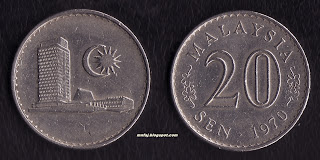 |
| image 1: coin A |
 |
| image 2: coin B |
 |
| image 3: coin C |
 |
| image 4: coin D |
I guess today is my lucky day! Sorry, not today, but yesterday to be precise. I found these 4 pieces of 1970 coins from my balance of only RM2 balance. Wonderful isn't?
All four coins in a circulated condition, so I decided to make experiment onto these coins. I bought a bottle of Brasso and I cleaned 2 of the coins!
For those who still do not know, cleaning coins is a very bad towards your collecting ethics. Cleaning your coins alters your coins original condition, particularly removing their wonderful lustre. And if the cleaning is proceeded with vigorous rub, then some details will be corroded or grinded by the polishers.
So, if cleaning the coin is bad, why I did it? This is an experiment, so I want to see myself what are the differences between cleaned coins and non-cleaned coins. In this case, I assume that cleaning coins is bad because of two major reason. First, it removes the lustre of the coins, particularly the high-graded coins. Second, it alters the looks of the coin, particularly old and rare coin. Collectors would like to keep a coin in their original state, whether it is in high-grade or low-grade.
So, I guess it is okay to clean these coins because these coins are in low grade, not very rare and has lost all its lustre. And for the time being, it enhance the appearance of the coin.
I cleaned these coins by using cotton-bud with Brasso, rubbing it onto the coins very gently with minimal forces are exerted onto the coins.
So, as you can see in the images, the first two images (coin A and coin B) are the cleaned coins and the latter coin C and coin D are the uncleaned coin.
What do you think of cleaning coin?







































